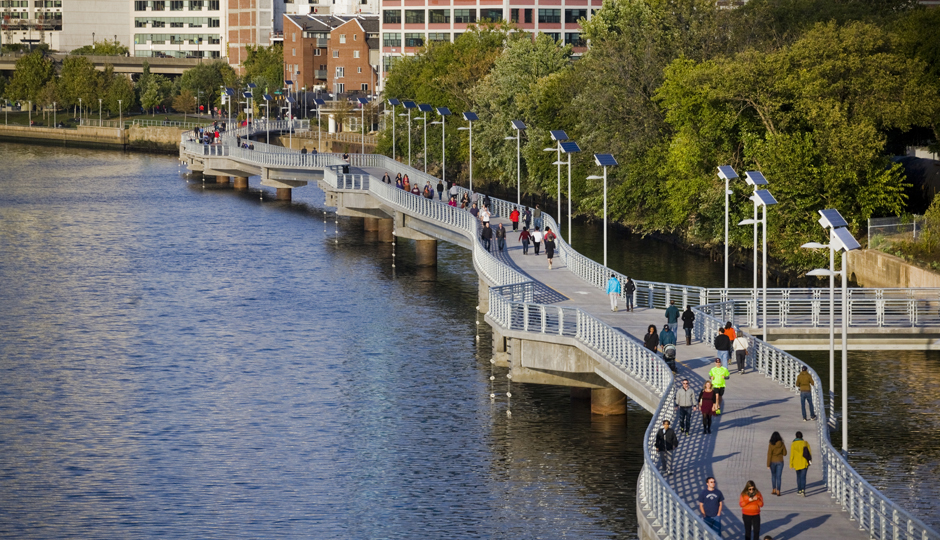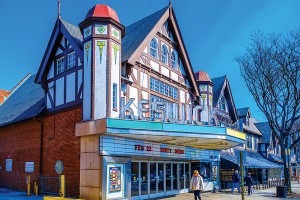The Circuit as Catalyst for Development

The Schuylkill Banks Boardwalk, a key connecting segment of the Schuylkill River Trail. The trail has become a magnet for real estate developers interested in marketing to clients seeking an active lifestyle and transportation choices. | Photo by M. Edlow for Visit Philadelphia™
Imagine: 750 miles of golden opportunities for real estate development geared towards the active lifestyle, stretching across nine counties in two states. On top of that, some of those 750 miles are being built by real estate developers themselves.
That’s one way to describe The Circuit, the growing regional network of bicycle trails designed to make bicycle transportation an integral part of the region’s overall transportation network.
“The Circuit is definitely a national leader if not an international leader in efforts to plan and connect bicycle trails across a large region,” says Matthew Norris, co-author of a recently released Urban Land Institute study, “Active Transportation and Real Estate: The Next Frontier,” which features the Schuylkill Banks boardwalk on its cover. “It’s gained a lot of traction and has been well received by the development community.”
The ULI study looks at how facilities for “active transportation” — bikeways, hiking trails, jogging paths and the like — have become development magnets that add value to adjacent projects. So desirable have such projects become, in fact, that developers in a number of locations have gone so far as to incorporate publicly accessible paths into their plans.
One such developer hereabouts is Brandywine Realty Trust, which built a segment of the Lawrence-Hopewell Trail in New Jersey through its Princeton Pike Corporate Campus at its own expense and is developing the FMC Tower at Cira Centre South adjacent to the Schuylkill River Trail.
Brandywine President, CEO and Trustee Jerry Sweeney also chairs the Schuylkill River Development Corporation, which is the agency in charge of extending the Schuylkill River Trail along the entire length of the river’s course through Philadelphia. “When I got involved with that, we were building our first building in the city, which is the Cira Centre adjacent to 30th Street Station. At that point, University City was in its embryonic stage of development, and being able to present our tenants with access to the Schuylkill River proved to be an attractive lure.”
In the decade since then, Sweeney’s civic interest and Brandywine’s commercial interests have been tied together by the trail. About the trail, Sweeney said, “I think the SRDC is moving very aggressively with plans to get down to Fort Mifflin on the Delaware.” He then rattled off the major progress made towards that goal over the last decade: first getting the trail to Locust Street, then to South Street via a boardwalk over the river. Opening the Grays Ferry Crescent and starting work on Bartram’s Mile, which will take the trail over to the river’s west bank and Bartram’s Garden. “We look at the Schuylkill River Trail, which is part of the Circuit, as a way to open up the river to the 20 or so neighborhoods along the tidal portion of the river.”
It’s also, as already noted, a way to lure tenants into Brandywine buildings, which the firm is doing again with the FMC Tower. The trail is being sold, along with the Cira Green park, a public park built by Brandywine on top of the parking garage next door to the tower, as one of the major recreational amenities occupants of this “vertical neighborhood” can enjoy. “We view trail networks and green spaces as part of our business strategy,” said Sweeney. “The environment in which we build our buildings and the amenities we offer outside our buildings are key attractors for tenants” in a very competitive real estate market.
Sweeney’s firm is not alone in taking this view. Another local developer that is pursuing a similar strategy is O’Neill Properties Group, a firm that specializes in brownfield reclamation projects and which also has several developments located along the Schuylkill River Trail. Like Brandywine, O’Neill is also tying the trail directly into its development program with The Royal Athena, a luxury apartment complex located along the river in Bala-Cynwyd. As part of the deal it struck with Lower Merion Township to get the project off the ground, O’Neill is building a trail segment that will connect with the Schuylkill River Trail in Manayunk via the Pencoyd Bridge and the Cynwyd Heritage Trail near where it crosses over the iconic Manayunk Bridge (aka Pencoyd Viaduct) via a future connection. O’Neill’s Millennium office complex is located along the trail in Conshohocken, and the firm has three trailside residential developments either in progress or planned in Bridgeport and Conshohocken.
“I think the trail is part of their marketing program, taking advantage of the things the trail brings to its customers,” said Sarah Clark Stuart, executive director of the Bicycle Coalition of Greater Philadelphia and chair of the Circuit Trails Coalition.
The Conshohocken developments are also an example of another factor reshaping how development takes place in cities and suburbs: Emphasizing maximum choice for occupants. In addition to a Circuit trail, Conshohocken also has SEPTA Regional Rail service and is located next to the junction of the Schuylkill Expressway and the Blue Route. Developments like these, Stuart said, indicate that “developers are very sensitive to the needs of their clients and customers to have access to multiple modes of transportation. People need to be able to access transit, biking and walking facilities” so customers, clients and visitors do not necessarily have to drive to their offices or homes. “People want choices in their ability to move, and a development will be more successful if it offers those choices to their residents.”
Even developers not known for their commitment to active lifestyles or environmental friendliness are climbing onto the two-wheeled bandwagon. “A lot of developers have built properties next to the Towpath Trail [in Manayunk] and are marketing their proximity to it,” Stuart said. “Dranoff on Venice Island and other developers were marketing it as an amenity, and when the Murano was marketing their condominiums, their marketing department also emphasized access to the Schuylkill River Trail.”
All this suggests that more people are also beginning to buy into the Circuit backers’ vision of bicycling as practical transportation once again. Before the rise of the automobile to dominance, bicycles were gaining popularity as basic transportation in the United States, and in a number of European countries, most notably Denmark and the Netherlands, they remain a key component of the transportation picture. The Bicycle Coalition of Greater Philadelphia has as part of its vision for 2020 a goal of biking and walking being perceived as “convenient, safe transportation choices” for trips under four miles. The Schuylkill River Trail, which incorporates the bike/pedestrian paths through Fairmount Park, has already become a major bike commuting route (PDF) to Center City for residents of Manayunk and other Northwest Philadelphia neighborhoods.
The symbiotic relationship between private developers and public facilities for active transportation is part of a growing trend worldwide, said Norris. “One of the main items we uncovered in looking into this issue is that there’s a growing number of bike trails, bike lanes and bike share systems popping up in cities around the world, and real estate developers are capitalizing on this infrastructure as a desirable location. Developers are leveraging these public investments and even building some of their facilities themselves to enhance their investments and just because it’s good business.”
While systematic studies putting price tags on the real estate value created by active transportation infrastructure are few and far between, there’s plenty of small-scale research quantifying their effect. One such study cited in the ULI report was conducted by the Green Space Alliance and the Delaware Valley Regional Planning Commission in 2011. That study found that properties within a quarter mile of the 2.4-mile-long Radnor Trail, another piece of the Circuit, were valued on average $69,000 higher than similar properties further away.
“Elsewhere in the United States, there are programs to create bicycle transportation facilities, but in terms of developing a bicycle transportation network, Philadelphia is a national leader along with the surrounding counties in Pennsylvania and New Jersey,” said Norris. And the development community in the region is happily reaping the benefits of the network effect.


